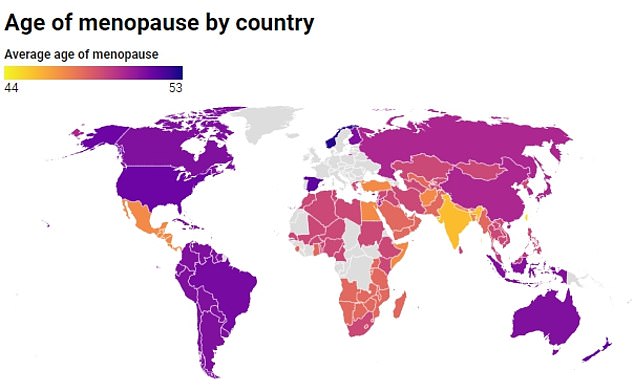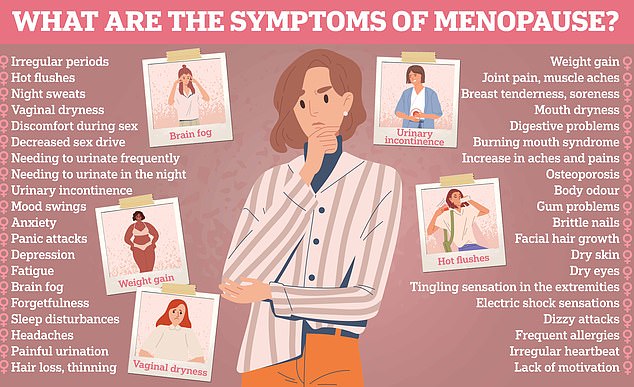How the age of menopause differs around the world – and the country where ‘the change’ begins in your 30s





Women in the eastern part of the world experience menopause earlier than others around the world.
An analysis from Universal Drugstore looked at the average age at which women around the world go through menopause and found countries where the oldest and youngest women were going through menopause.
On average, menopause begins at the age of 51. But women in Taiwan, India and Bangladesh can expect to begin the process in their mid-40s.
With an average age of 44.6 years, Taiwanese women experience menopause at the youngest age. Followed by India at 45.6 years old and Bangladesh at 47 years old – outliers among Asian countries.
The countries where women experience the process at the oldest age include Norway at 52.7 years old, Spain at 51.7 years old and New Zealand at 51.5 years old. With ages of 51.4, 51.2 and 51 years, the US, Brazil and Great Britain follow closely behind, respectively.
There are some geographic trends in the data. Many countries in South America have an average age for menopause of 51 years, while in Africa many countries have an average age of 48 or 49 years.
In Asia, the average age of menopause is 49 or 50 years in most countries.
The World Population Organization said better health care and wider access to it are generally associated with an older age at menopause.

Menopause can bring hot flashes, irritability and anxiety (stock photo)
However, in lower socio-economic countries, where access to health care is more limited, women tend to have younger children, which can contribute to an earlier menopause.
But experts told DailyMail.com that more research is needed to determine how geography, culture, diet or socio-economics play a role in menopause.
Dr. Amanda Shea, Chief Science Officer at Clue – an app that tracks menstruation and ovulation – told DailyMail.com: ‘The timing of menopause is influenced by a wide range of things, including genetic, biological, environmental and socio-economic factors.
‘For example, research has found links between age at menopause and factors such as smoking, obesity, child birth and diet.’
Menopause is a natural biological process that marks the end of a woman’s menstrual cycle and fertility.
Around the world, the average age at menopause is between 44 and 53 years.
Signs include irregular periods, hot flashes and mood swings leading to irritability, anxiety or depression.
Menopausal women may also experience vaginal dryness, sleep disturbances, weight gain, and changes in their skin or hair color.


Symptoms can begin up to 10 years before menopause and last up to 14 years. However, the average duration of symptoms is about seven years.
Treatment options include hormone therapy and lifestyle changes, such as limiting saturated fats and eating more fruits and vegetables.
In the analysis, the youngest five countries were Mexico and Egypt, which also had an average age of 47, according to Universal Drugstore. analysiswhich was based on data from the World Population Organization.
Dr. Shea added, “…trends in [menopause] The onset varies by country and changes over time.
‘These variations highlight the crucial need for further research to better understand the underlying factors driving these trends and their implications for the daily lives of women and people with cycles, especially as life expectancy increases and we spend more years in menopause.’
Dr. Navya Mysore, medical director of women’s health at Nurx, a women’s healthcare company, told Daily Mail.com: ‘It’s difficult to say whether geographic trends, genetics, diets and cultures influence the age at which menopause begins. The fact is that we need more research to better understand the situation in different cultures and ethnic groups.
‘We know that some ethnic groups experience menopause differently than others. For example, many Japanese women experience fewer hot flashes than other races and ethnicities.
“This could be because Japanese women’s diets may contain more soy,” she added.
Soy contains isoflavones, a type of plant estrogen that mimics the hormone naturally produced in the body. Menopause – and the hot flashes that come with it – begins when the body stops producing estrogen.
This, Dr. Mysore suggests, may be why women who eat a diet high in soy experience fewer menopausal symptoms. However, she cautioned that there is limited data to confirm this.

Regardless of the cause, Dr. Shea said that both early and late menopause have “significant health consequences.”
She told this website: ‘For example, premature menopause is linked to an increased risk of cardiovascular disease and high blood pressure, while delayed menopause is associated with an increased risk of breast, endometrial and ovarian cancer.’
Premature menopause is also known as primary ovarian insufficiency (POI) and occurs when a woman’s ovaries stop working and she experiences menopause before the age of 40, while early menopause occurs when menopause occurs between the ages of 40 and 45.
Early menopause occurs in about five percent of women and POI occurs in only one percent of women under the age of 40.
It can be the result of genetics or family history, as well as certain diseases or treatments, such as cancer and chemotherapy, removal of the uterus or ovaries, and certain autoimmune diseases.
Research has shown that the long-term health effects of premature menopause include heart disease, neurological diseases, mood disorders, osteoporosis and premature death.
However, a special one study The hormone therapy found may reduce some, but not all, of these risks.
This includes taking medications that contain the female hormone estrogen, which the body stops producing when a woman enters menopause.
On the other hand, delayed menopause occurs when a woman reaches menopause in her late 50s or early 60s.
Genetics, obesity, having children and pregnancy later in life can contribute to delayed menopause.
A 2014 study found that delayed menopause is associated with an increased risk of breast, endometrial and ovarian cancer; but also a reduced risk of osteoporosis and death from heart disease, and a longer reproductive lifespan.
Regardless of trends or patterns, Dr. Shea said more research needs to be done “to better understand the factors contributing to these differences.”
‘Specifically, improving our ability to predict individual perimenopause and menopause experiences based on a person’s unique characteristics and circumstances could enable more women to better prepare for and manage health changes over the course of manage time, which would ultimately improve their overall quality of life.”




